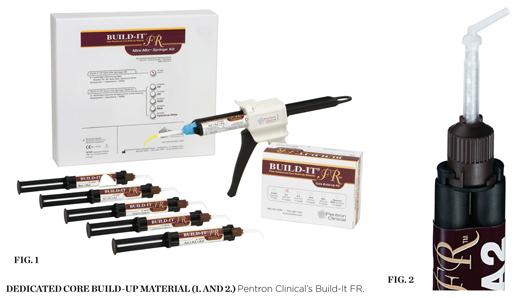Build-It FR Fiber-Reinforced Core Material
There are many benefits to using a dedicated core material.
A core build-up is frequently an important part of the restorative process. When a tooth has been severely weakened or when not enough clinical crown exists any longer to support the final restoration, a build-up is necessary to ensure the long-term prognosis of both the prosthesis and the biological structure.
Unfortunately, confusion abounds on which materials are best for an efficient and long-lasting build-up procedure. From a clinical standpoint, a practitioner needs a material that: is easy to place and easy to manipulate and sculpt if needed; sets quickly; is bonded to the tooth to minimize the need for mechanical retention; cuts with a similar feel to tooth structure; provides adequate strength; provides adequate retention and will not be displaced by removal of the temporary restoration; supports the final restoration; and helps ensure long-term stability.
Dedicated Build-up Materials
Materials that are designed and manufactured to be dedicated build-up materials are the clinician’s best choice. These materials offer many benefits of the composite build-up while also offering some other advantages.
Dedicated materials are bonded to place using standard bonding techniques. This ensures adequate retention of the material and stability of the permanent prosthesis. These materials also have an amazing amount of strength, especially those that are fiber-reinforced such as Build-it FR. They are strong with high measurements of flexural strength and compressive strength. When set, they are easy to prepare as part of the crown procedure.
Pentron Clinical’s Build-It FR (Figure 1 and Figure 2) is available in three tooth-colored shades (A2, A3, Opaceous White), which means they can be placed under all porcelain restorations without affecting the final shade. Build-It FR is also available in two easily identifiable contrast shades, blue and gold, for areas where visualization is difficult. Of course these shades must be used with some type of material that will mask these underlying colors (zirconia, etc). When identifying the build-up is a must, these colors are just the trick.
Build-It FR is dual-cure so bulk placement is not a deterrent to their use. The dual-cure aspect means it can be placed in bulk with no concerns regarding inadequate curing. The auto-polymerizing components will self-cure whether a curing light is used or not, meaning bulk filling can be accomplished with no concerns for failure. This makes it ideal for large build-ups and clinical situations such as build-ups over a prefabricated post where occasionally access to condensing a material is extremely limited. A lower-viscosity material can flow into hard to reach areas and then self-cure for the best possible bond.
Placement is also easier with Build-It FR since it is delivered via an auto-mixing dual-barrel syringe or cartridge. This ensures a proper quantity and mixture of both chemical components. Special intraoral tips can be attached to the syringe, which allow the material to be delivered via the syringe directly into the preparation. This greatly simplifies the placement process and allows the operator to place the material with greater control. The amount of voids in the material is greatly decreased by placement in this manner.
Conclusion
While many options exist in the choice of materials for use as a build-up for fixed prosthetics, the operator must carefully consider many factors in making that choice. While composite is certainly an effective build-up material, dedicated core build-up materials like Build-It FR offer more advantages with fewer drawbacks.
For more information, contact:
Pentron Clinical Technologies
Phone: 800-551-0283
Web: https://www.pentron.com
Disclaimer
The preceding material was provided by the manufacturer. The statements and opinions contained therein are solely those of the manufacturer and not of the editors, publisher, or the Editorial Board of Inside Dentistry. The preceding is not a warranty, endorsement, or approval for the aforementioned products or services or their effectiveness, quality, or safety on the part of Inside Dentistry or AEGIS Communications. The publisher disclaims responsibility for any injury to persons or property resulting from any ideas or products referred to in the preceding material.
About the Author
This article was written by John C. Flucke, DDS.




